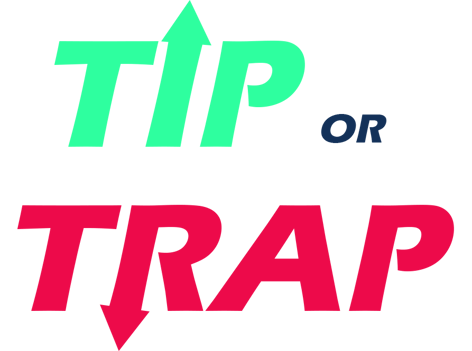
Insurance Sales Game Show
The Internet is full of guides to help grow your agency, but as a wise man once said, "just because it's on the internet, doesn't make it true." To help you sort through the good and bad of sales processes, we've brought together four sales experts from across the industry. We'll be looking at six popular sales methods, and our experts will break down whether those methods are a tip to grow faster or a trap that'll have you seeing red.
Introducing our sales experts:

Mick Hunt - CEO, Premier Strategy Box

Kelly Donahue-Piro - President, Agency Performance Partners

Brent Kelly - Vice President, Sitkins Group Inc.

Brian Ahearn - Chief Influence Officer, Influencepeople
And last but not least, our host for this event, Katherine Ternes, VP of Revenue at AgencyZoom
Sales Methods
Sales Method #1: SPIN
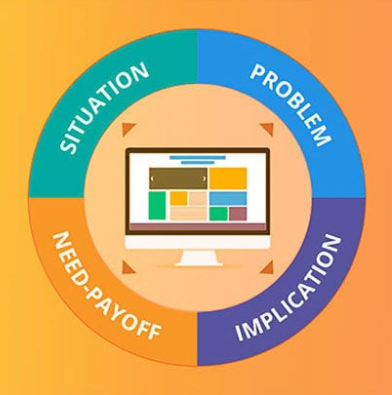
SPIN is an acronym for Situation, Problem, Implication, and Need-payoff. It's a less aggressive approach, built around asking these four key questions to build a relationship with leads. Let's see what our experts have to say:
Mick Hunt - Tip
Kelly Donahue-Piro - Tip - Questions and communication are your friends. You want to identify, clarify and educate clients to lead them to the best solutions.
Brent Kelly -Tip -The key to any effective sales situations is driven by the quality of your questions. While I don't specifically teach around the SPIN method, any quality agent would spend time preparing great questions that would cause the prospect to pause, think, and answer in terms of your value.
Brian Ahearn - Trap - Showing how a product will alleviate a pain is effective after a problem has been diagnosed. However, this could be a trap because matching the product outside of an agreed upon presentation and NDA leaves you open to the possibility of some prospects taking your work back to the current agent.

Sales Method #2: Challenger
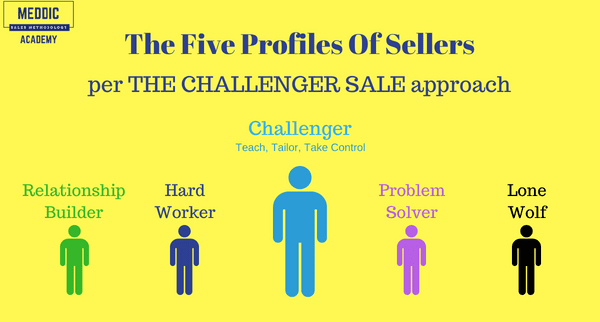
Based on the 2013 novel, The Challenger Sale: How To Take Control of the Customer Conversation the Challenger model breaks down the five different kinds of sales reps and expands upon the challenger profile. A challenger teaches customers and takes control in encouraging them to challenge their current beliefs about your product. Let's see what our experts have to say:
Mick Hunt - Tip
Kelly Donahue-Piro - Tip -Too many personal and small commercial agents quote first and sell second. You want to start every new business phone call by listening and educating the client on why you are hands down the best solution.
Brent Kelly - Trap - I don't know if this is a "Trap," but it is a a bit complicated and I think sales conversations have too many unknown variables. I don't think people care nearly as much about your credentials as they do you understanding them and their main concerns.
Brian Ahearn - Trap - 1. Much better to have a 3rd party introduction because a 3rd party can say things about you that will sound like you're bagging if you say them. You can control the message by sharing with the 3rd party what you want in an introduction. 2. Addressing misconceptions is good but I'm not sure how a rep will know what problems a prospect has at this point. 3. People make the vast majority of decisions based on emotions, not logic. It's always best if a rep can get a prospect to feel the emotion. For example, explaining a coverage will not be as effective as having a real story to illustrate the impact of the coverage on a person or business. 4. Always need to show value. 5. Showing the value to the prospect is always good.

Sales Method #3: Sandler

According to Sandler Training, their sales method "was inspired by watching movies about World War II, when submarines were attacked to avoid flooding the crew moved through each compartment, closing the door of the previous compartment behind them. The Sandler Selling System requires the same procedure to avoid “disaster” on a sales call. Your goal is to move through each compartment, or step of the selling system, to arrive safely at a successful sale."
Mick Hunt - Tip - I teach this process!!!!
Kelly Donahue-Piro - Tip -The upfront contract is a great way to set the rules of the road so everyone is on the same page and not wasting valuable time!
Brent Kelly -Tip - Absolutely agree that we must present ourselves as a trusted advisor. Prospects don't care about your products...they care about their solutions.
Brian Ahearn - Tip - No one wants to be sold. The best compliment a salesperson can hear from a prospect is, "I never felt sold." The goal should be to inform people into yes. You do this in combination of an effective sales process and application of proven psychology.

Sales Method #4: Way of the Wolf
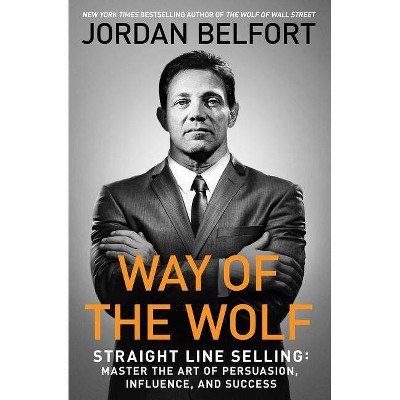
Based on legendary salesman, Jordan Belfort, Way of the Wolf is a three step method to control any sale. 1) Build rapport with prospects 2) Determine if they're qualified leads 3) Stay in control of the conversation.
Mick Hunt - Tip
Kelly Donahue-Piro - Tip - You will lose your value when you aren't in control of the call and the opportunity.
Brent Kelly -Tip - I'm unsure of "Way of the Wolf," but I do think we need to control the conversation through our questions and define the specific rules of the game before engaging in further discussions. Our time is too valuable.
Brian Ahearn - Trap - I'm all for keeping conversations on track so time and efficiency is maximized but I really dislike the notion of controlling clients. If clients knew control was your aim, they wouldn't be clients for long. The more you understand how people think, make decisions, and behave, the easier it will be to communicate the value of your product. I believe you can use research from social psychology and behavioral economics to have better conversations throughout the sales process.

Sales Method #5: SOLUTION

Solution selling is a four step sales process developed by Frank Watts in the 1970s. The four steps are: 1) Excellent Product Knowledge. 2) Have a game plan ready. 3) Ask the right Questions. 4) Suggest a solution.
Mick Hunt - Tip
Kelly Donahue-Piro - Tip - One tip we give agents is to work to uncover problems a client didn't know they had. Make sure you are focused on listening and developing the strategy.
Brent Kelly -Tip - Although I am much less concerned about what the competition is doing, I do believe that every salesperson should be prepared and ready to ask impactful questions. The best questions cause the other person to say, "No one has ever asked me that before."
Brian Ahearn - Tip - People won't make a change unless there's a compelling reason. That's usually a problem or pain point. Having a list of questions to uncover pain points is always a good idea as is a defined sales process. However, with both there needs to be flexibility in the same way that a sports team might need to deviate from the game plan when necessary. I believe understanding your customers, the market and competitors, and working on your sales skills are all necessary for success.

Sales Method #6: GAP
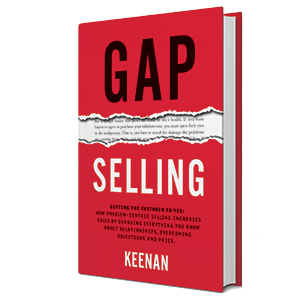
GAP selling is a newer sales technique debuting in the 2018 novel of the same name by Keenan. The ideology is a buyer-centric model focusing on bridging the gap between where customers are today and where they want to be in the future, using your product as a bridge.
Mick Hunt -Trap - Insurance consumers don't mimic this process. The buying process is different.
Kelly Donahue-Piro - Tip - Gaps can be in coverage and experience don't just focus all of it on their insurance coverage!
Brent Kelly -Tip - I agree with the "Buyer centric" mentality. Every time you speak to a prospect, remember that they are tuned in to ONE radio station, WII-FM (what's in it for me). People buy for one of two reasons, to avoid pain or gain pleasure. Pain is more powerful and you need to ask questions to share how you will improve their state.
Brian Ahearn - Tip - Most insureds don't know what they don't know and have false assumptions about what is and is not covered. Research shows people are much more likely to make a decision when they think they will lose vs. gain. Knowing that, showing gaps in coverage followed by clear explanations of what they potentially stand to lose can be effective.



